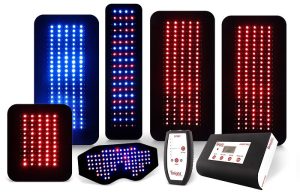Photobiomodulation Therapy at KIHC

What is photobiomodulation therapy?
Photobiomodulation (PBM) therapy is a form of light therapy. Many of us already know that our body uses light to modulate hormones (melatonin and vitamin D, for example). Therapeutically, you may have heard of dermatologists using blue light to treat difficult skin conditions or physicians recommending the use of full-spectrum light to address seasonal depression. The PBM technology we use applies light wavelengths from the red (visible) and near-infrared (invisible) spectrum that travel deeper into the body to address a variety of chronic pain conditions, fatigue, and neurological illness. It is also made of LED (“Light Emitting Diodes”) rather than LASER (“Light Amplification by Stimulated Emission of Radiation”) lights.
How does photobiomodulation work?
PBM is a fast-evolving science that so far, focuses on at least 2 main mechanisms of action:
- Microcirculation: Light waves penetrate the skin and trigger local blood vessels to dilate, bringing much needed oxygen and nutrients to the treatment area.
- Mitochondria: These are the “power houses” in nearly all human cells, that directly absorb these light waves and respond with increased energy production (or “ATP” molecules) that can be used to repair damaged tissues.
Our Inlight Therapy device also emits light waves in particular pulsed patterns (frequencies), believed to offer additional healing support for the tissue being targeted. I’m personally interested in the newer research that explores how these light waves impact water structure and charge around our cells.
What kinds of conditions respond to photobiomodulation therapy?
Given that PBM addresses circulation and energy production in cells, many health conditions have been researched for their response to PBM, including:
- Chronic pain (e.g. back pain, TMJ, joint or muscle pain)
- Acute pain (e.g. bone fractures)
- Neurological illness and health (e.g. brain injury, Alzheimer’s disease, anxiety, Restless Legs Syndrome)
- Hair loss
- Immune modulation (e.g. autoimmune disorders, allergies)
Additional research is ongoing for its impact on brain function, the lymphatic system (which carries our immune cells and removes waste products), and our microbiome. Understanding this might help us understand why light therapy on one part of the body has far-reaching effects on other parts of the body.
Though much research has been done, much more is required. Consequently, we consider PBM therapy to be an adjunctive and sometimes experimental treatment (i.e. not a stand-alone treatment). Further, these devices are only FDA approved for certain pain conditions. Ask your practitioner whether PBM therapy might be appropriate for your health concerns.
What is photobiomodulation therapy like?
Inlight Therapy pads look a bit like a blood pressure cuff but with dozens of tiny lights on one side. These pads are hooked up to a “controller box” that manages how the lights function. Pads might be placed directly over your area of concern, or on a different area of your body that contributes to the problem in some way. Your practitioner will choose the best area to apply these pads and the program most suited to your health concern.
Therapy is usually most effective when the pads lightly touch the skin, so wear comfortable and loose-fitting clothing. People generally feel nothing or only mild sensations during the treatment process. The program runs for up to 20 minutes.
How safe is photobiomodulation therapy?
Inlight Therapy devices do not emit UV rays and are not the same as tanning beds. The effect is also “photo-chemical” and not thermal, meaning that these devices do not cause heat damage. These devices are considered safe for home use.
The research is unclear in a few areas, and so best to avoid light therapy if you have cancer, suspected cancer, a seizure disorder, or are pregnant.
How do I access these treatments at KIHC?
Some of our practitioners have been trained to use Inlight Therapy devices. Ask your practitioner about using the Inlight Therapy pads during your treatment session. We also have devices available for KIHC clients to rent, for 2 weeks of daily use at home. If you notice positive results and would like to purchase your own device, we can order you one and will subtract 1 week of the rental fee from the final cost. (The price for a typical small unit with 2 therapy pads, starts at about $1700USD.)
You can also purchase your own device from KIHC and find more purchasing information on our website, here.
Where can I find more information about photobiomodulation?
Research and use of light therapy technologies goes back to the 1960s, though the clinical effects of light wavelengths emitted by Light Emitting Diodes (LEDs) such as what we’re using, perhaps only appeared in the literature in the 1990s.
Its potential for treating neurological conditions is highlighted in a recent “Nature of Things” episode with David Suzuki on CBC – this time hosted by Dr. Norman Doidge, the author of “The Brain that Changes Itself”.
To date, there are reportedly more than 1300 clinical trials conducted on light therapy. A good portion of this research is led by Michael Hamblin at Harvard Medical School. Links to two of his published articles are listed below.
You can also look up more current research about PBM using the MeSH heading “Photobiomodulation”. (A MeSH heading is the term used by the National Institute of Health to categorize research.) Other useful terms to add to your search include the older term “Low-Level Light Therapy” (LLLT), or “Polychromatic Light Therapy”.
Hamblin, Michael. Mechanisms and Mitochondrial Redox signalling in Photobiomodulation. Photochem Photobiol; 2018: 199-212. Doi: 10.111/php.12864
Hamblin, Michael. Shining Light on the head: Photobiomodulation for brain disorders. BBA Clinical; 2016: 113-124. Doi: 10.1016/j.bbacli.2016.09.002
Low-Level Light Therapy, Lyme disease, pain, photobiomodulation